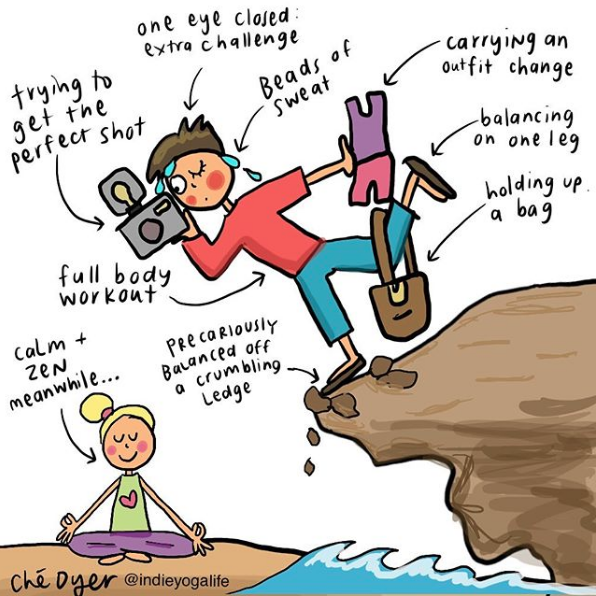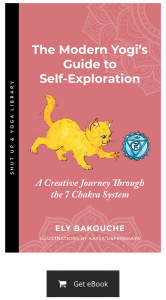Hello, my name is Julie Tran, and I am a recovering Yoga Addict.
One day, I was sitting in a chair doing a video podcast for my Science Yoga Sunday series. After the session was over, I started to stand up. Before I could stand all the way up, my left femur bone slid out of its socket. Unfamiliar with this sensation of a bone popping out of my body, I wriggled and made a dancing movement akin to “The Elaine” in Seinfeld in hopes of putting the femur back in. It worked. However, a few days later, I got out of bed, sat up, and tried to stand up, and the femur slipped out again.
In the orthopedic doctor’s office, the words “hypermobility,” “necrosis,” and “possible hip replacement” reached my ears like a warped record screeching ever so slowly to a full stop. I realized that I was at high-risk for a hip replacement. What brought tears to my eyes was the fact that I was only 35.

I am currently undergoing physical therapy, and it is predicted that it will take 2-3 years for me to get to some sort of normalcy. Even then, I will have to maintain my stability program for as long as I live. Wait, “Yoga Addict” wasn’t just a catchy phrase?
This is going to be a very sobering tale (with a splash of sarcasm). I’m going to tell you about some pervasive things going down in the yoga world that put a lot of us yoga addicts at risk. Things that many teachers are keeping silent about for various reasons — to protect their guru’s yoga system, to put out only positive vibes when speaking to the universe, to promote the idealized notion that yoga is the one-stop-shop for health, wellness, and spirituality, or even just to protect their own reputations.
The Injuries
Before I dig into my story, here is the list of yoga-related injuries I’ve incurred so far:
- Herniated cervical disks (C6 and C7)
- Stage 2 Tear in the coracohumeral ligament (of the shoulder)
- Inflammation and hypermobility in both shoulders
- Inflammation, necrosis, and hypermobility in the left hip
- Bonus: Inactive gluteus muscles (which isn’t technically an injury, but it plays its part in this sobering tale)
Now, some very dedicated yogis have responded to hearing about these injuries with sentiments like “yoga is life,” “injuries teach us about ourselves,” “work through the pain,” “just work on your alignment,” “just engage your Bandhas,” and “practice and all is coming.” You fools, your Instagram Yoga challenge is what got me into this mess in the first place! I say this as I shake my fist in the sky.

How I really got myself into this mess
Ok, ok, I know. We humans have the final choice on what to do with our lives. So, while it’s really not “so-and-so’s” fault for launching an Instagram challenge that involves arm balances, handstands, splits, and passive hip openers to exponentially grow her following for my chance to win hot pink leggings that would make my weakened “yoga booty” look om-mazing… (wooooo…… Exhale……), Western yoga’s current obsession with looking “right” definitely put me (and puts others) at risk. Let me explain.
#YogaEveryDamnDay
You know this hashtag. It’s got over a million posts, so it is “trending.” “#YogaEveryDamnDay” is used on most social media platforms, and it represents the idea that someone is a true and legit yogi because he/she is practicing asana every single day. It’s akin to the Ashtanga system where you practice 6 days and rest the 7th (and on New/Full Moon days) — except you don’t rest because you “can’t stop won’t stop.”
Search that hashtag on Instagram and scroll through the feed. Quickly, now! What do you see?
Maybe the results just look like people practicing yoga in front of the camera.

Me? I see posed photographs that don’t give me any information about the yogi’s spiritual practice or breathwork, or whether or not they actually prepared their joints safely for that snapshot. Yet, so many of us look at these acrobatic models who are at some beach, mountain, or jungle “expressing the full version of the pose,” and feel pressure to look like them when in actuality they might have a completely unique bone structure that allows them to move beyond most people’s natural range of motion. Many who see these images think they embody all that yoga is, and some get triggered and avoid yoga altogether because they don’t have the same body structure. All in all, the “practice” of sharing only our physical poses on Instagram can be a damaging imbalance. Keep reading to find out just how damaging it can be.
I fell in love with teaching yoga, so I should get more people to learn from me. That’s what social media is for, right?
I commend the other traveling yogi, Hawk, who writes for Shut Up & Yoga, because she is completely off of social media. No handle, no one to tag for the credit, nothing but the good old fashioned phone call and email. She is truly liberated from the trappings of the likes and the comments.
But unlike her, I fell into the Instagram culture trap — and I fell hard. Before I embarked on traveling the world with my husband and cats (yes, they have a pet passport), I lived in San Francisco, CA. In order to even be considered for some teaching gigs, I had to prove that I had a large Instagram following because (in the studio owner’s eyes) this meant free marketing to fill classes. All the followers would just magically come to class and reduce the overhead needed for standard advertising costs.

Problem: I didn’t have a large following. I had about 2,500, most from my previous small health coaching business. And in reality, that number was dropping after those people saw that my content was shifting from gym selfies to pictures of yoga challenge poses and mindfulness quotes. So I had to do something to get my numbers up before I could get the jobs I wanted.
Becoming a yoga robot
I thought that if I led challenges like the famous personalities, taught like them, and dressed like them, I would get more followers and be a successful small online yoga business owner. The irony is that I became so dogmatic about it, it went against my motto of “yoga without the dogma.” I paid for bots that searched pre-loaded hashtags, followed them, and unfollowed them if they didn’t reciprocate. At first, the bots brought me to amazing people who I loved to converse with over modern yoga. But then they started bringing in junk accounts or followers with content that I just wasn’t on the same wavelength with. I didn’t know who these folks were.

I also joined “Instagram pods” which involved groups of other female teachers (or yoginis) commenting on each other’s posts with “very nice alignment!”, double-tapping for the “hearts”, and trying to game the algorithm so that our posts wouldn’t get shoved to the bottom of our followers’ feeds. Sure enough, my engagement spiked for a bit — but then I realized that my previous followers had stopped interacting with me, that the only comments were coming from the people in the pods, and that my conversion rate (followers to customers) was still at a low of 2%.
And my husband was getting fed up with being that “Instagram Boyfriend.” Sick and tired of taking a slew of photographs for me, dealing with my growing angst about not looking “aligned enough,” and seeing me turn into a complete Yoga Social Media Robot… He threatened divorce. What was I doing, and why was I doing this? I am an Asian-American woman with very wide hips, unsculpted abs, and no desire to get a spray-tan or carry a bunch of sponsored leggings anywhere. Yet, I was trying to follow the formula in hopes of getting recognized. I was trying to mimic the “Instagram Stars,” so I could make a full-time income as a yoga teacher, but I was doing it at the cost of my spiritual happiness. This meaningless dogma was not worth it.

The shift before the storm
I should’ve realized how bad things were getting when I interviewed Diane Bruni. She told me how one day, her hamstrings just popped right off the bones from doing years of “hip openers” and relaxing her glutes. At the time, I just hoped I wouldn’t experience that myself, but I mostly carried on with business as usual.
After interviewing Garrett Neill and hearing about hip replacements at age 30, I even began to shift the way I practiced “hip openers,” away from hypermobility and toward my natural range of rotation instead.
But it was too late. The 15+ years of traditional asana practice had caught up to me anyway. On top of all of my other injuries, I had just been told that my left femoral head might experience necrosis (death of the bone), meaning I would eventually need a hip replacement.
So, what part of my yoga practice could have led to this?
There isn’t one single suspect. But, I’m positive my urge to be part of the Instagram yoga culture didn’t help. Repeatedly contorting my body into poses that don’t work for me, just to get a picture? That’s not my yoga.
While I don’t want to fear monger any of you into not practicing your favorite asana, below is a list of things that my physical therapists and orthopaedic doctor deduced to have led me to reach this point. It’s important to know that your genetics, bone structure, and daily movement habits are your own, and they’re all probably very different from mine. What you see in this list is what occurred to me, so if you enjoy practicing any of these poses, it is all up to you to choose to do them with an educated and self-aware mind:
**TLDR (Too Long? Didn’t wanna Read?) The likely suspects of my yoga-related injuries are genetics, an imbalance of flexibility vs. strength, and a lack of motor control.**
Let’s go from the top down. Did all those attempted headstands and shoulder stands lead to my herniated C6 and C7 discs? What lead to a ligament tear and hypermobility in both shoulders? Doing all those Chaturangas without properly strengthening my upper body to support the weight, and transitioning from Chaturanga to Cobra/Updog to Downdog.

How about those inactive glutes? Intentionally and repeatedly relaxing my glutes in Cobra and Bridge Pose — I trained them to shut off.
Now for the devastating hip injury I will spend the rest of my life dealing with. Ready for the list? Trying to square the hips in Warrior I when it is anatomically impossible for most women. Transitioning from Warrior I to Warrior II without resetting the pelvis. Transitioning from Warrior III to Ardha Chandrasana without resetting the back foot. Doing long sequences on one standing leg without giving the hip socket a break. Requesting hip openers in yoga classes because it “felt good.” Lotus pose (enough said). Sitting passively in pigeon pose and child’s pose while letting teachers “assist” me by pressing down on my sacrum. That almost certainly contributed to the inactive glutes, too.
In general, my tendencies toward obsessing over “alignment” and how straight my limbs should be probably worsened my natural hypermobility. All of these injuries were made worse because I ignored the pain and aches in my joints because I wanted to get that picture and “win” on the mat. I also sat for long hours in a chair to do all of my online yoga marketing. And, I made the mistake of thinking that just yoga asana would be sufficient strength building — in retrospect, I needed to be weight training with an external load to keep up with my increasing hyperflexibility.

Notice a pattern? It was none of these things in isolation that contributed to my injuries. I fell victim to the idea that asana is the only necessary exercise, and I didn’t do enough to mitigate the effects of doing the same movements over and over. But mostly, I didn’t listen to my own body — I just kept going, to get the shot for Instagram, of all things!
After finally getting into somatics and developing better self-awareness, I stopped ignoring the pain and got the problems checked out. I stopped putting value in my social media stats. I stopped trying to please the sea of unknown faces who simply double-tapped or commented with a generic “DM me for a bracelet!”. I just simply stopped doing yoga for others.
Waking the f*ck up (or where this journey now?)
Since writing this article, I have taken a long hiatus from Instagram to nurture my body-mind. The process of weeding out all of the accounts the bots followed has been tedious and spiritually draining. But, it has served as a constant reminder of how I will never market my Rogue Yogi brand again. I check into IG from time to time to get inspired by my modern yoga friends, receive grateful messages from new friends for content that’s still relevant to their practice, and bring myself back to my breath. Waking the f*ck up and breaking up with most of social media has given me time to explore the other limbs of yoga, be inspired by other wellness modalities, practice mindfulness, and fall in love with my spirituality again.
Maybe you’re a teacher who’s feeling pangs of doubt about what you’re posting on social media. Maybe you’re questioning the need for aesthetic poses and valuing the enriching sensation of your body’s natural movement and how it makes you feel. It’s NOT too late to change the direction of your yoga. Every choice, every variation of a pose, every modification can be an educated and empowered one for you.

More resources from Shut Up & Yoga:
Here are articles that invite reflection on the notion of modification, variation, alignment, injuries, and evidence-based yoga for long-term health:
- Carly Stong’s How to Use Language to Make Yoga Classes More Inclusive
- Nick Combs’ Enough with Child’s Pose: A Practice Guide to Accessible Yoga
- Katy Hooks’ Why Traditional Adjustments Should Be a Thing of the Past
- Daniella Bush’s Breaking Yoga Alignment Stereotypes
- Kerry McInnes’ Modern Yoga: Rethinking Outdated Cues
- Dr. Yogi Gare’s 5 Most Common Injuries (and How You Can Avoid Them) book, below:
Edited by Jaimee Hoeffert, Scientist Yogini





